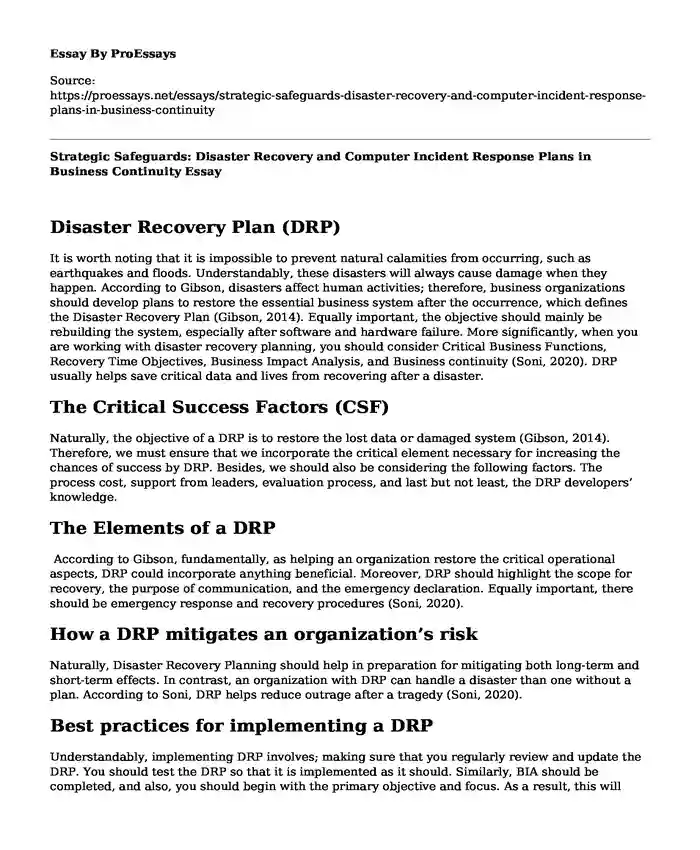Disaster Recovery Plan (DRP)
It is worth noting that it is impossible to prevent natural calamities from occurring, such as earthquakes and floods. Understandably, these disasters will always cause damage when they happen. According to Gibson, disasters affect human activities; therefore, business organizations should develop plans to restore the essential business system after the occurrence, which defines the Disaster Recovery Plan (Gibson, 2014). Equally important, the objective should mainly be rebuilding the system, especially after software and hardware failure. More significantly, when you are working with disaster recovery planning, you should consider Critical Business Functions, Recovery Time Objectives, Business Impact Analysis, and Business continuity (Soni, 2020). DRP usually helps save critical data and lives from recovering after a disaster.
The Critical Success Factors (CSF)
Naturally, the objective of a DRP is to restore the lost data or damaged system (Gibson, 2014). Therefore, we must ensure that we incorporate the critical element necessary for increasing the chances of success by DRP. Besides, we should also be considering the following factors. The process cost, support from leaders, evaluation process, and last but not least, the DRP developers’ knowledge.
The Elements of a DRP
According to Gibson, fundamentally, as helping an organization restore the critical operational aspects, DRP could incorporate anything beneficial. Moreover, DRP should highlight the scope for recovery, the purpose of communication, and the emergency declaration. Equally important, there should be emergency response and recovery procedures (Soni, 2020).
How a DRP mitigates an organization’s risk
Naturally, Disaster Recovery Planning should help in preparation for mitigating both long-term and short-term effects. In contrast, an organization with DRP can handle a disaster than one without a plan. According to Soni, DRP helps reduce outrage after a tragedy (Soni, 2020).
Best practices for implementing a DRP
Understandably, implementing DRP involves; making sure that you regularly review and update the DRP. You should test the DRP so that it is implemented as it should. Similarly, BIA should be completed, and also, you should begin with the primary objective and focus. As a result, this will help address every essential concern.
Mitigating Risk with a Computer Incident Response Team Plan
Computer Incident Response Team (CIRT) Plan
More imperatively, a computer incident is an abuse of security policy that involves activities affecting the system (Gibson, 2014). More precisely, they can cause losses of business integrity, confidentiality, and accessibility. According to my research, the Computer Incident Response Team is a group of experts trained to reduce an organization’s damages. Therefore, the objective of CIRT is to ensure there is appropriate control of multiple computer components. More appropriately check on inappropriate usage within the system. Additionally, the help detects malicious codes and Denial of Service (DoS) attacks (Gibson, 2014).
The elements of a CIRT plan are
Fundamentally, the CIRT should be able to outline the policy information. Equally significant, are communication means and membership information (Gibson, 2014). Additionally, there should be an exact incident response procedure. However, the actors are not always limited, as long as they are essential.
How a CIRT plan can mitigate an organization’s risk
Notably, CIRT helps a business get ready to respond faster to incidents. However, the risk should be identified first. Similarly, the organization should identify the CIRT members who are well-equipped with the skills and knowledge needed. Conclusively, it enables every individual to know what role and task to play during emergencies.
The Best practices for implementing a CIRT plan
More importantly, the organization should train the CIRT members to respond and handle the situation (Gibson, 2014). Then, impose rules guiding CIRT member’s operations and include a developed checklist. Equally important, the business should subscribe to security notifications to be alert when malicious codes pop up.
References
Gibson, D. (2014). Managing risk in information systems. Jones and Bartlett Learning. 2nd Edition. 9781284055955 https://www.oreilly.com/library/view/managing-risk-in/9781284055955/
Soni, V. D. (2020). Disaster recovery planning: untapped success factor in an organization. Available at SSRN 3628630. https://papers.ssrn.com/sol3/papers.cfm?abstract_id=3628630
Cite this page
Strategic Safeguards: Disaster Recovery and Computer Incident Response Plans in Business Continuity. (2024, Jan 24). Retrieved from https://proessays.net/essays/strategic-safeguards-disaster-recovery-and-computer-incident-response-plans-in-business-continuity
If you are the original author of this essay and no longer wish to have it published on the ProEssays website, please click below to request its removal:
- Report Sample on Peculiarities of Doing Business in Turkey
- Essay on Personal Learning Network
- Teens and the Internet: Annotated Bibliography
- The Benefits of Integrating Marketing and Management Strategies in Entrepreneurial Organizations
- Challenges Faced by American (United States) Companies in Foreign Markets
- The Technology Employed by Tres Latin Foods Companies Paper Example
- Paper Example on Air Pollution in the US: 2018 Data & Overview







